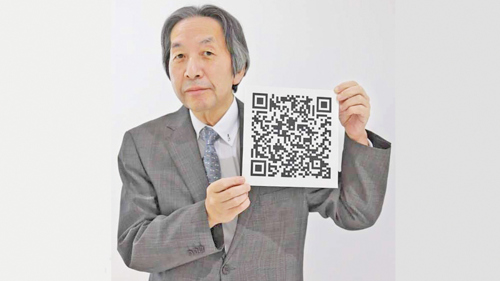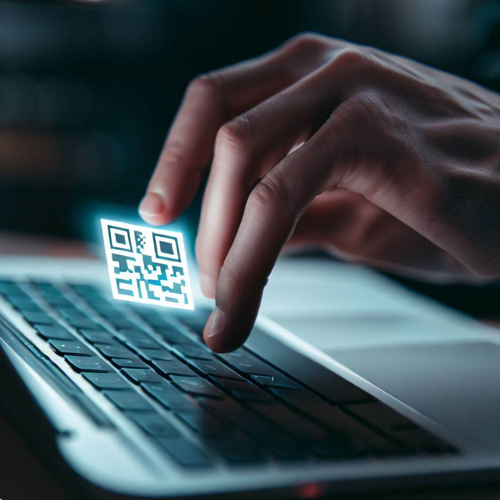In the modern digital age, QR codes have become an integral part of our lives. From product packaging to advertisements and even event tickets, these scannable square codes are ubiquitous. They simplify information exchange, enhance marketing strategies, and offer a seamless connection between the physical and digital worlds. In this blog, we'll delve into the fascinating history of QR codes, explore their inventor, explain how they work, and discuss their evolution over time.
The full form of QR codes is Quick Response codes.

Invention and Historical Context:
QR codes were invented in 1994 by Masahiro Hara, a Japanese engineer at Denso Wave, a subsidiary of the Toyota Group. The creation of QR codes was initially driven by the need to improve upon traditional barcodes, which could only store limited information horizontally.

Hara sought to develop a code that could be scanned at high speeds, contained a significant amount of data, and could be read in any orientation. Inspired by the two-dimensional matrix barcodes used in the manufacturing industry, Hara and his team created the QR code, capable of storing several hundred times more information than a traditional barcode.
Working Principle of QR Codes:
QR codes are two-dimensional codes that consist of black and white squares arranged in a square grid on a white background. Each QR code is unique and can store a variety of information, such as URLs, text, contact details, and more. The process of encoding and decoding QR codes involves the following steps:
-
Encoding: To create a QR code, a specific encoding algorithm is used. The information to be stored is converted into a binary code format and divided into various sections, such as data, error correction, format information, and version information.
-
Structured Arrangement: The encoded data is then structured by dividing it into modules, which are the individual black or white squares in the QR code. These modules form a matrix grid that can range from 21x21 to 177x177 squares, depending on the version of the QR code.
-
Positioning Patterns and Alignment: To assist with accurate scanning and decoding, positioning patterns and alignment patterns are added to the QR code. These patterns enable the scanning device to determine the orientation and size of the code.
-
Error Correction: QR codes utilize Reed-Solomon error correction codes to ensure data integrity. This technique enables the code to withstand minor damages or obstructions, such as smudging, tearing, or a small portion of the code being obstructed.
-
Scanning and Decoding: To read a QR code, a smartphone or other scanning device equipped with a camera captures an image of the code. The decoding software on the device processes the image, recognizes the patterns, and extracts the encoded information.

Evolution and Utilization:
Initially, QR codes were primarily used in the automotive industry for tracking vehicle parts during manufacturing. However, as smartphones became more prevalent, their potential for broader applications was realized. Today, QR codes are extensively employed across various domains, including marketing, logistics, payments, and more. Some notable advancements and applications of QR codes include:
-
Marketing and Advertising: QR codes revolutionized marketing strategies by enabling companies to seamlessly connect print and digital media. By scanning a QR code on a billboard, poster, or product packaging, consumers can instantly access websites, videos, promotional offers, or product details.
-
Mobile Payments: QR codes are instrumental in mobile payment systems, such as Alipay and WeChat Pay in China. Users can scan a merchant's QR code to make payments directly from their smartphones, eliminating the need for physical currency or credit cards.
-
Contactless Information Sharing: QR codes facilitate the sharing of contact details, Wi-Fi passwords, event tickets, and more through a simple scan. This eliminates the need for manual input or sharing physical documents, making the process quick and convenient.
-
COVID-19 Response: During the global pandemic, QR codes played a vital role in contact tracing efforts. Many countries implemented QR code-based systems that individuals could scan upon entering public places, enabling authorities to track potential COVID-19 exposure and mitigate the spread of the virus.
-
Authentication and Security: QR codes are increasingly used for authentication and security purposes. Two-factor authentication systems often incorporate QR codes, where users scan a code displayed on a device or computer screen to verify their identity.
-
Product Authentication: QR codes can be employed to verify the authenticity of products and combat counterfeiting. Consumers can scan the code on a product to access information about its origin, manufacturing details, and other relevant data, ensuring the legitimacy of the item.
-
Digital Ticketing: QR codes have transformed the ticketing industry by replacing physical tickets with digital ones. Attendees can simply present their QR code tickets on their smartphones for entry to events, reducing the risk of ticket loss or forgery.
-
Loyalty Programs: QR codes are utilized in loyalty programs to track customer interactions and provide rewards. By scanning codes at checkout or participating in specific activities, customers can earn points or discounts, fostering customer engagement and retention.
Future Prospects and Enhanced Capabilities:
As technology continues to advance, QR codes are expected to evolve and offer even more functionalities. Some potential advancements include:
-
Design Customization: QR codes can be customized with colors, logos, and patterns while still maintaining their scannability. This opens up opportunities for branding and creative integration within marketing materials.
-
Enhanced Error Correction: Future QR codes may feature improved error correction techniques, enabling the retrieval of data even in situations where a significant portion of the code is damaged or obscured.
-
Augmented Reality Integration: QR codes can be integrated with augmented reality (AR) experiences, allowing users to scan a code and unlock interactive digital content overlaid on the physical world.
-
Dynamic QR Codes: Rather than containing static information, dynamic QR codes can be updated in real-time. This versatility allows for dynamic content delivery, inventory management, or personalized user experiences.
FREE QR CODE GENERATOR
Link: TWI QR CODE GENERATOR
Conclusion: QR codes have come a long way since their invention in 1994, transforming the way we interact with digital information in our daily lives. From their humble origins in the automotive industry to their widespread adoption in marketing, payments, and beyond, QR codes have become a powerful tool for seamless information exchange and connection. As technology continues to advance, we can expect QR codes to evolve further, offering new possibilities and enhancing our digital experiences.
Discover More
Most Viewed
Christmas is a season of joy, love, and traditions. And what better way to get into the holiday spirit than through timeless carols? These musical gems have been bringing people together for generations. Here’s our ranked list of the Top 10 Christmas Caro…
Read More

















